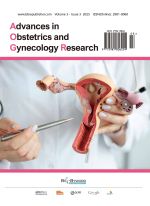Abstract
Objective: To explore the relationship between premature rupture of membranes (PROM) in late pregnancy and diseases related to maternal and neonatal infections. Methods: A retrospective analysis was conducted on the clinical data of 300 cases of PROM puerperas (Group A) and 200 cases of normal delivery puerperas (Group B) who gave birth at Datong Fifth People’s Hospital from January 2021 to December 2023. The amniotic fluid contamination, placental pathology, maternal and neonatal infection indicators, and the incidence of perinatal infectious diseases were compared between the two groups. Results: The degree of amniotic fluid contamination in the PROM group was lower than that in the control group (P < 0.01), but the incidence of bloody amniotic fluid was higher (P < 0.05). The infiltration rate of inflammatory cells in the placenta was significantly higher in Group A than in Group B (P < 0.01). In Group A, the white blood cell count, neutrophil percentage, and procalcitonin levels of the puerperas were significantly increased (P < 0.05). The incidence of intra-amniotic infection, neonatal respiratory distress syndrome, and meconium aspiration syndrome was higher in Group A (P < 0.05). The white blood cell count and neutrophil indicators of neonates were significantly elevated in Group A. Conclusion: Premature rupture of membranes in late pregnancy significantly increases the risk of maternal and neonatal infections. Joint monitoring of multiple laboratory indicators and rational use of antibiotics are important for improving outcomes.
References
Chi J, 2021, Correlation between Group B Streptococcus Infection in the Genital Tract of Pregnant Women in Late Pregnancy and Premature Rupture of Membranes and Neonatal Outcomes. Journal of Clinical and Pathological Research, 41(3): 571–576.
Magrini L, Gagliano G, Travaglino F, et al., 2014, Comparison between White Blood Cell Count, Procalcitonin and C Reactive Protein as Diagnostic and Prognostic Biomarkers of Infection or Sepsis in Patients Presenting to Emergency Department. Clin Chem Lab Med, 52(10): 1465–1472.
Oliveira C, Flôr-de-Lima F, Rocha G, et al., 2019, Meconium Aspiration Syndrome: Risk Factors and Predictors of Severity. The Journal of Maternal-Fetal & Neonatal Medicine, 32(9): 1492–1498.
Brown R, Marchesi J, Lee Y, et al., 2018, Vaginal Dysbiosis Increases Risk of Preterm Fetal Membrane Rupture, Neonatal Sepsis and Is Exacerbated by Erythromycin. BMC Medicine, 16(1): 9.
Hincu M, Zonda G, Vicoveanu P, et al., 2024, Investigating the Association between Serum and Hematological Biomarkers and Neonatal Sepsis in Newborns with Premature Rupture of Membranes: A Retrospective Study. Children (Basel), 11(1): 124.
Olicker A, Raffay T, Ryan R, 2021, Neonatal Respiratory Distress Secondary to Meconium Aspiration Syndrome. Children, 8(3): 246.
